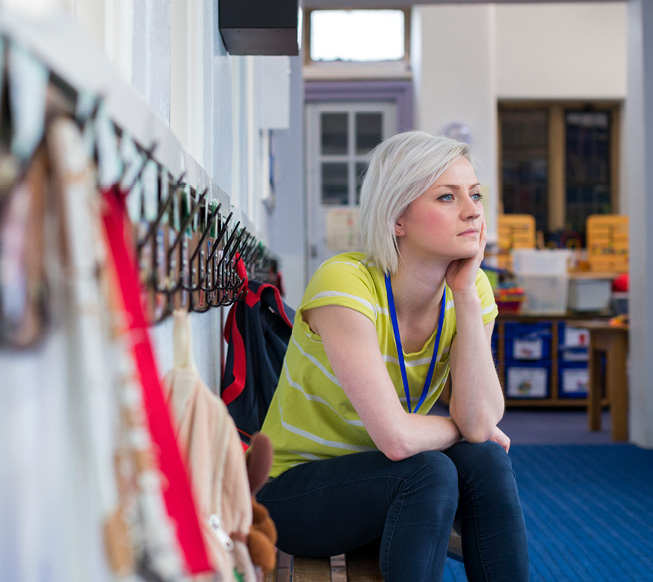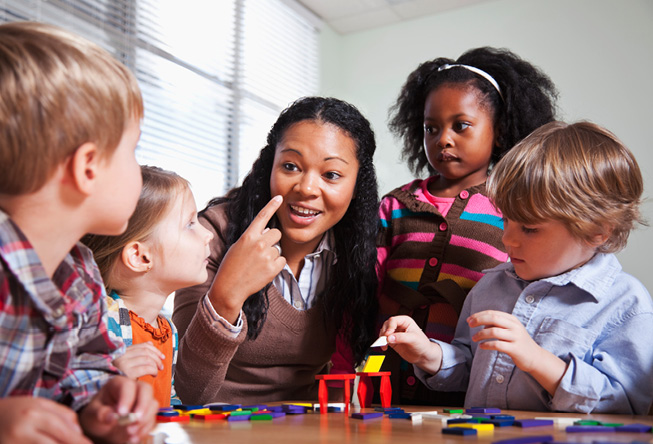Preventing Compassion Fatigue: Caring for Yourself

You are here
Our new book is about healing and hope. For children. For children’s families. And for you, the early childhood educator. Trauma touches everyone. If left unchecked, it is likely to leave harm in its wake. That is why you must be vigilant and proactive, both with those you work with and yourself. In this article, we focus on how you can prevent the ill effects of trauma from creeping into your own life. The self-care strategies highlighted here will help you remain strong and healthy enough to be the champion for children and families with histories of trauma that you want and need to be.
 Self-care may not be the first thing that comes to mind when most people think of dealing with trauma. As an educator, your focus is first and foremost on the children you teach. You also work with family members to support children’s learning goals. You carve out time as needed to work with specialists who support the children, team with colleagues, meet with supervisors, and interact with members of the community.
Self-care may not be the first thing that comes to mind when most people think of dealing with trauma. As an educator, your focus is first and foremost on the children you teach. You also work with family members to support children’s learning goals. You carve out time as needed to work with specialists who support the children, team with colleagues, meet with supervisors, and interact with members of the community.
You devote a lot of time, energy, and professional responsibilities to many other people, but you may not devote enough time to yourself.
Being an early childhood educator can be both physically and mentally exhausting. Preschoolers and kindergartners are whirlwinds of energy, exploring, experimenting, and making discoveries. They depend on you to put them first, meeting their needs and helping them attain their aspirations. At the same time, they bring joy as you see them mastering tasks, learning new concepts, and appreciating you for being such an important part of their lives. But there is no denying that they can drain you of energy and leave you feeling spent.
When you add trauma to the situation, the chances that you will sometimes feel overwhelmed and find it difficult to go on increase dramatically. Children who have experienced trauma often respond to it in ways that test your patience and push you to the limit. Children who are in survival mode can be aggressive, rude, uncooperative, and inattentive. And until you are able to help children feel calm and safe and learn to self-regulate, you cannot focus on other kinds of learning.
Your own compounding stress
If you have endured the same traumatic experiences as the children—a natural disaster, school violence, or a national crisis such as the COVID-19 pandemic—you share similar fight-flight-freeze responses in your life. You may be dealing with issues like the loss of personal property or you may even be grieving the death or injury of a loved one.
In addition, like a number of early childhood educators, you may also be a survivor of your own childhood traumas, which may or may not have been resolved. Hearing of children’s experiences and fears can bring back unhappy memories that temporarily paralyze or haunt you.
Moreover, if your program or home is in a neighborhood characterized by violence or poverty, you are likely to experience the same ongoing traumas as the children you teach. For you and them, traumas are an ongoing concern.
 The early childhood profession can itself be a source of financial stress. Despite the recognized importance of early education in children’s lives, it is among the lowest-paying fields (Nicholson et al. 2020). Many early childhood teachers hold down supplemental jobs to earn a living wage. The economic stresses of being an early childhood professional are felt hardest by women of color, who make up 40 percent of the early childhood profession (Austin et al. 2019) and are more likely to work in lower-paying education positions than White educators.
The early childhood profession can itself be a source of financial stress. Despite the recognized importance of early education in children’s lives, it is among the lowest-paying fields (Nicholson et al. 2020). Many early childhood teachers hold down supplemental jobs to earn a living wage. The economic stresses of being an early childhood professional are felt hardest by women of color, who make up 40 percent of the early childhood profession (Austin et al. 2019) and are more likely to work in lower-paying education positions than White educators.
All of these pressures can put chronic stress on educators each day. Before you even begin your day with young children, you may already be feeling the economic squeeze of low wages and perhaps prejudice and racism as well. The selflessness it takes to work with, nurture, and teach young children is a testament to the commitment that those who have chosen this profession have.
The good news is that you can take action to counteract your own stress. In the following sections, we will briefly explore some of the stress-related conditions early childhood educators may experience and offer practical ideas that you can implement to ease the stress of your job. Stress does not have to take a toll when self-care is a priority. As the saying goes, you need to be well to do well. And by doing so, you can position yourself to enjoy teaching’s many rewards.
Defining teaching-related stress
As society has learned more about trauma and its effects, researchers have begun to look at how educators who work with young children with trauma are affected by the experience. In doing so, they have defined and delineated how stress-related manifestations are triggered, what the symptoms are, and how they can be treated.
Burnout is probably the best known of these phenomena. Burnout is “a reaction to prolonged or chronic job stress [that] is characterized by three main dimensions: exhaustion, cynicism (less identification with the job), and feelings of reduced professional ability” (Freudenberger & Richelson 1980). Burnout can bring about physical, psychological, cognitive, and relational disturbances (Nicholson et al. 2020; Transitional Support, n.d). While you may experience burnout from your job, however, it is not directly tied to working with children with trauma.
Secondary trauma conditions that stem from absorbing the impacts of others’ trauma go by several names, including secondary traumatic stress, compassion fatigue, and vicarious traumatization (Bride, Radey, & Figley 2007). Empathy fatigue, empathic distress, and empathy distress fatigue are newer terms for health problems brought on by stress (Alber 2018). Although all of these conditions are related, there are nuances that differentiate them that are further explained in our book.
The selflessness it takes to work with, nurture, and teach young children is a testament to the commitment that those who have chosen this profession have.
Secondary traumatic stress (STS) is the term most commonly found in the literature to describe the phenomenon brought on by helping someone exposed to trauma. A more recent term is compassion fatigue, often perceived as a kinder, less stigmatizing way to describe this phenomenon. According to the NCTSN (2011) and the Administration for Children & Families (n.d.), the terms STS and compassion fatigue are interchangeable and refer to the same condition.
While the symptoms of compassion fatigue vary from individual to individual, they most typically involve empathic drain and chronic exhaustion. Other symptoms resemble those experienced by individuals with post-traumatic stress disorder (PTSD), such as fear, guilt, anxiety, apathy, sense of hopelessness, sleep disturbances, nightmares and intrusive thoughts, hypervigilance, short-temperedness, and a denial of problems. These symptoms can further express themselves in compulsive behaviors (overspending, overeating, gambling) and drug use to mask feelings (NCTSN 2011; Nicholson et al. 2020; Administration for Children & Families, n.d.; Compassion Fatigue Awareness Project, n.d.; Gunn, n.d.).
Everyone who teaches children with a trauma background is susceptible to developing compassion fatigue. Some early childhood educators, however, are more likely than others to develop this condition: women, new teachers, those who are most empathic by nature, and those who have their own unresolved personal traumas (NCTSN 2011; Ollison 2019).
 Using self-care to overcome secondary trauma
Using self-care to overcome secondary trauma
If you experience secondary trauma, you are not alone. Those who experience it do so because they are deeply empathic and take children’s traumas to heart. All early childhood educators need to know this because secondary trauma can happen to anyone and, most important, it can be effectively addressed.
Self-care is often categorized as self-indulgence. Many people regard it as pampering used by those without the self-discipline to “get on with things.” Even those who don’t think of self-care as selfish or wasteful frequently regard it as a low-priority or luxury activity. Yet self-care is basic to our everyday existence. Rather than view self-care as self-indulgence, try reframing it as self-respect.
Self-care strategies
Self-care involves incorporating activities aimed at restoring and improving your physical and emotional well-being into your everyday life. The National Child Traumatic Stress Center (NCTSN 2011) recommends focusing on cognitive–behavioral and mindfulness-based strategies for best results. Regularly using the ideas suggested here will help you heal from secondary stress and fortify you for the future.
Be kind to yourself
This strategy could be called “respect yourself,” because tending to your basic wellness needs should not be a favor or privilege you extend yourself but something you do every day to be your healthiest and best-functioning self. As a kindness to yourself and those you work with, attend to your physical, social, mental health, emotional, and spiritual needs as best you can (Scott 2019). Here are some ideas:
- Physical needs: regularly eat nutritiously balanced meals; sleep adequately; exercise regularly; and monitor and attend to your health needs, making and keeping needed doctor and dental appointments and taking any medications as prescribed.
- Social needs: cultivate and maintain close friendships. Everyone has different social needs, but we all have need to share others’ company in some capacity. Determine what your needs are and build time into your schedule to have the face-to-face time with your friends that feels right for you.
- Mental health needs: do activities to keep your mind sharp, such as working crosswords and other puzzles, reading books, or researching a topic or subject you are interested in and passionate about. To be mentally healthy, you need to be proactive. If you feel depressed, anxious, or otherwise troubled, talk about it with a doctor or therapist. Treatment can make a world of difference.
- Emotional needs: establish appropriate ways to process your emotions. Talk to someone close to you—a spouse, partner, relative, or friend—to air your feelings and talk through problems. Journal your feelings; seeing things written out sometimes gives a different slant to events. Exercise, take baths, or spend time doing hobbies, such as painting, that allow you to relax and refocus. Remember that alcohol and other drugs can suppress your feelings rather than help you manage and lessen your distress. They may even intensify your emotional or physical pain.
- Spiritual needs: nurturing your spirit involves doing things that bring meaning to your life and a connection with the world. It doesn’t have to involve religion, although it certainly can. Build in time for praying, meditating, or volunteering for a cause that enriches your soul.

Cultivate mindfulness
Mindfulness is one of the most successful strategies for counteracting the effects of compassion fatigue (NCTSN 2011). Over time, mindfulness practices help you develop increased emotional regulation and the ability to tolerate emotional challenges. The effects of mindfulness extend your ability to better accept professional and personal frustrations with relationships.
The Foundation for a Mindful Society (2019) suggests the following exercise as a starter:
- Set aside some time. You don’t need a meditation cushion, bench, or any sort of special equipment to access your mindfulness skills—just time and space.
- Observe the present moment as it is. The aim of mindfulness is not quieting the mind or attempting to achieve a state of lasting calm. The goal is to pay attention to the present moment without judgment.
- Let your judgments roll by. When you notice judgments arise, make a mental note of them and then let them pass.
- Return to observing the present moment as it is. Our minds often get carried away in thought. That’s why mindfulness is the practice of returning, again and again, to the present moment.
- Be kind to your wandering mind. Don’t judge yourself for whatever thoughts crop up. Just practice recognizing when your mind has wandered off and gently bring it back.
Reframe your negative thoughts
Learning how to reframe pessimistic thoughts is known as cognitive restructuring. Part of cognitive behavioral therapy (CBT), it can be done at home and has been shown to be effective in treating depression and anxiety. The NCTSN (2011) suggests that combining this strategy with mindfulness may be particularly effective in addressing secondary trauma. Thinking optimistically is also known to have great personal benefits, including better physical and emotional health, greater self-efficacy, longer life, and greater career satisfaction (Seligman 2005; Colker & Koralek 2019).
Over the last 30 years, psychologists have found that optimism can be learned, no matter how innately pessimistic a person may be or how negative their life circumstances have been (Seligman 2005). By working through what has been dubbed the ABCDE model, educators can learn to reframe their negative thinking (Hall & Pearson 2004). Our book also explains how to use this model with children.
You can be the change agent who gives children an opportunity to rewrite their life stories with promise and hope.
When you have an experience that triggers pessimistic thoughts, use self-talk to walk your thoughts from A (adverse event) to E (energization) (based on Seligman 2005, 2007):
A = An adverse event occurs.
B = You immediately have some negative beliefs and thoughts about the adverse event.
C = You experience the consequences of having these thoughts and beliefs, including negative emotions
D = You intentionally dispute your pessimistic beliefs.
E = You feel energized when you successfully dispute your negative thoughts and realize that the situation is not as you initially believed.
It will take more than one attempt at this process to transform your pessimism into optimism. But with time and effort, reframing your beliefs, thoughts, and emotions is possible and can become your regular way of thinking.
When you make cognitive restructuring a part of your self-care routine, you will make inroads against the symptoms of compassion fatigue and position yourself to be a role model for children on thinking positively.
Make a self-care action plan
Because self-care tends to be neglected, it is helpful to develop an action plan. Setting two or three SMART goals at a time will keep you focused. SMART goals (Doran 1981; Haughey 2014; MindTools, n.d) are
Specific: What exactly are you trying to accomplish? Why is this goal important to you? What resources or limits are involved?
Measurable: How much effort will it take? How many people are involved? How will you know you accomplished it?
Assignable: Who will do it?
Realistic: Is this worthwhile? What results can realistically be achieved given available resources?
Time related: When, specifically, can it be achieved? What can you do today?
A goal might be Each night I will practice mindfulness for five minutes before I go to bed.
Although it can be tempting to try to make sweeping changes in your lifestyle, like drastically changing your exercise routines or eating habits, realistically that is hard to sustain. We suggest you begin slowly—with only two or three goals to start. This will keep you from feeling overwhelmed and allow you to adjust as needed. Once they become routine, add another goal or two.
Conclusion
With your healing-centered interventions, perseverance, and compassionate teaching, the effects of traumas can be turned around for the children you teach, their families, and you. Children’s histories do not have to be the prologue to the rest of their lives. As trauma therapist and author Karen Saakvitine proclaims, “Everyone has a right to have a present and future that are not completely dominated and dictated by the past” (Klinic Community Health Centre 2013, 4). You can be the change agent who gives children that opportunity to rewrite their life stories with promise and hope.
References
Administration for Children & Families. n.d. “Secondary Traumatic Stress. What Is Secondary Traumatic Stress?” Administration for Children & Families. Accessed March 12, 2020. www.acf.hhs.gov/trauma-toolkit/secondary-traumatic-stress.
Alber, R. 2018. “When Teachers Experience Empathic Distress.” Edutopia, April 18. www.edutopia.org/article/when-teachers-experience-empathic-distress.
Austin, L.J.E., B. Edwards, R. Chavez, & M. Whitebook. 2019. “Racial Wage Gaps in Early Education Employment.” Center for the Study of Child Care Employment, December 19. https://cscce.berkeley.edu/racial-wage-gaps-in-early-education-employment/.
Bride, B.E., M. Radey, & C.R. Figley. 2007. “Measuring Compassion Fatigue.” Clinical Social Work Journal 35: 155–63.
Colker, L.J., & D. Koralek. 2019. Making Lemonade: Teaching Young Children to Think Optimistically. St. Paul, MN: Redleaf.
Compassion Fatigue Awareness Project. n.d. “Recognizing Compassion Fatigue.” Accessed February 12, 2020. www.compassionfatigue.org/pages/symptoms.html.
Doran, G.T. 1981. “There’s a S.M.A.R.T. Way to Write Management’s Goals and Objectives.” Management Review 70 (11): 35–36.
Foundation for a Mindful Society. 2019. “Getting Started with Mindfulness.” www.mindful.org/meditation/mindfulness-getting-started/.
Gunn, J. n.d. “Self-Care for Teachers of Traumatized Students.” Resilient Educator. Accessed March 6, 2020. https://education.cu-portland.edu/blog/classroom-resources/self-care-for-teachers/.
Freudenberger, H.J., & G. Richelson. 1980. Burnout: The High Cost of High Achievement. Norwell, MA: Anchor Press.
Hall, D.K., & J. Pearson. 2004. Introducing Thinking Skills to Promote Resilience in Young Children. Reaching IN…Reaching OUT (RIRO). Toronto: Child & Family Partnership.
Haughey, D. 2014. “A Brief History of SMART Goals.” Project Smart, December 13. www.projectsmart.co.uk/brief-history-of-smart-goals.php.
Klinic Community Health Centre. 2013. Trauma-Informed: The Trauma Toolkit. 2nd Edition. http://trauma-informed.ca/wp-content/uploads/2013/10/Trauma-informed_Toolkit.pdf.
MindTools. n.d. “SMART Goals.” Accessed February 5, 2020. www.mindtools.com/pages/article/smart-goals.htm.
NCTSN (The National Child Traumatic Stress Network). 2011. “Secondary Traumatic Stress: A Fact Sheet for Child-Serving Professionals.” www.nctsn.org/sites/default/files/resources/fact-sheet/secondary_traumatic_stress_child_serving_professionals.pdf.
Nicholson, J., P.S. Driscoll, J. Kurtz, D. Marquez, & L. Wesley. 2020. Culturally Responsive Self-Care Practices for Early Childhood Educators. New York: Routledge.
Ollison, J. 2019. “Improving Teacher Retention by Addressing Teachers’ Compassion Fatigue.” PhD diss., University of the Pacific. https://scholarlycommons.pacific.edu/uop_etds/3602.
Scott, E. 2019. “5 Self-Care Practices for Every Area of Your Life.” Verywellmind, July 25. www.verywellmind.com/self-care-strategies-overall-stress-reduction-3144729.
Seligman, M.E.P. 2005. Learned Optimism: How to Change Your Mind and Your Life. New York: Vintage Books.
Seligman, M.E.P. 2007. The Optimistic Child: A Proven Program to Safeguard Children Against Depression and Build Lifelong Resilience. Boston: Mariner Books.
Transitional Support. n.d. “Burnout vs. Compassion Fatigue.” Transitional Support. Accessed April 1, 2020.
http://transitionalsupport.com.au/transitional-phase/compassion-fatigue-trauma/.
Photographs: © Getty Images
Sarah Erdman is an experienced early childhood educator and museum professional in Northern Virginia. She teaches at FB Meekins Cooperative Preschool. [email protected]

Laura J. Colker, EdD, is president of L.J. Colker & Associates, in Washington, DC. She is an author, a lecturer, and a trainer in early childhood education with 40 years of experience. [email protected]

Elizabeth C. Winter, MD, is a board-certified psychiatrist in Baltimore, Maryland. She is a senior physician with the Department of Veterans Affairs, Office of the Inspector General and a faculty member of the Johns Hopkins Hospital Department of Psychiatry and Behavioral Sciences.
